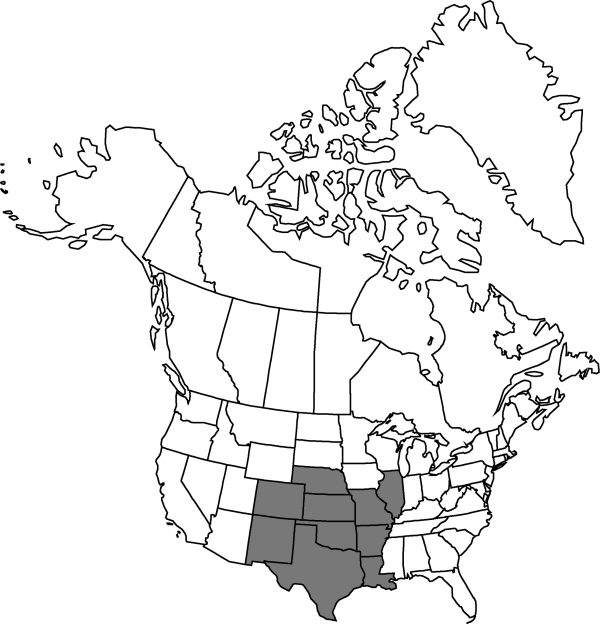Difference between revisions of "Phemeranthus calycinus"
Novon 11: 320. 2001.
Endemic
Basionym: Talinum calycinum Engelmann in F. A. Wislizenus, Mem. Tour N. Mexico, 88. 1848
Synonyms: Claytonia calycina (Engelmann) Kuntze
FNA>Volume Importer |
imported>Volume Importer |
||
| (6 intermediate revisions by 2 users not shown) | |||
| Line 7: | Line 7: | ||
|year=2001 | |year=2001 | ||
}} | }} | ||
| − | |basionyms={{Treatment/ID/ | + | |special_status={{Treatment/ID/Special_status |
| + | |code=E | ||
| + | |label=Endemic | ||
| + | }} | ||
| + | |basionyms={{Treatment/ID/Basionym | ||
|name=Talinum calycinum | |name=Talinum calycinum | ||
|authority=Engelmann | |authority=Engelmann | ||
| + | |rank=species | ||
| + | |publication_title=in F. A. Wislizenus, Mem. Tour N. Mexico, | ||
| + | |publication_place=88. 1848 | ||
}} | }} | ||
|synonyms={{Treatment/ID/Synonym | |synonyms={{Treatment/ID/Synonym | ||
|name=Claytonia calycina | |name=Claytonia calycina | ||
|authority=(Engelmann) Kuntze | |authority=(Engelmann) Kuntze | ||
| + | |rank=species | ||
}} | }} | ||
|hierarchy=Portulacaceae;Phemeranthus;Phemeranthus calycinus | |hierarchy=Portulacaceae;Phemeranthus;Phemeranthus calycinus | ||
| Line 29: | Line 37: | ||
|elevation=100-1200 m | |elevation=100-1200 m | ||
|distribution=Ark.;Colo.;Ill.;Kans.;La.;Mo.;Nebr.;N.Mex.;Okla.;Tex. | |distribution=Ark.;Colo.;Ill.;Kans.;La.;Mo.;Nebr.;N.Mex.;Okla.;Tex. | ||
| − | |discussion=<p>Some populations of Phemeranthus calycinus are diploid while others are tetraploid, the latter probably the result of autopolyploidy (W. H. Murdy and M. E. B. Carter 2001).</p> | + | |discussion=<p>Some populations of <i>Phemeranthus calycinus</i> are diploid while others are tetraploid, the latter probably the result of autopolyploidy (W. H. Murdy and M. E. B. Carter 2001).</p> |
|tables= | |tables= | ||
|references= | |references= | ||
| Line 38: | Line 46: | ||
-->{{#Taxon: | -->{{#Taxon: | ||
name=Phemeranthus calycinus | name=Phemeranthus calycinus | ||
| − | |||
|authority=(Engelmann) Kiger | |authority=(Engelmann) Kiger | ||
|rank=species | |rank=species | ||
| Line 52: | Line 59: | ||
|publication title=Novon | |publication title=Novon | ||
|publication year=2001 | |publication year=2001 | ||
| − | |special status= | + | |special status=Endemic |
| − | |source xml=https:// | + | |source xml=https://bitbucket.org/aafc-mbb/fna-data-curation/src/2e0870ddd59836b60bcf96646a41e87ea5a5943a/coarse_grained_fna_xml/V4/V4_998.xml |
|genus=Phemeranthus | |genus=Phemeranthus | ||
|species=Phemeranthus calycinus | |species=Phemeranthus calycinus | ||
Latest revision as of 23:02, 5 November 2020
Plants to 4 dm; roots fleshily woody. Stems ascending or erect, simple or branching. Leaves sessile; blade subterete, to 7 cm. Inflorescences cymose, much overtopping leaves; peduncle scapelike, to 25 cm. Flowers: sepals persistent, ovate to suborbiculate, 4–6 mm; petals pink- to red-purple, obovate, 10–15 mm; stamens 25–45; stigma 1, subcapitate, 3-lobed. Capsules broadly ovoid, 6–7 mm. Seeds without arcuate ridges, 1 mm. 2n = 24, 48.
Phenology: Flowering May–Oct.
Habitat: Rocky or sandy soil, on or near outcrops
Elevation: 100-1200 m
Distribution

Ark., Colo., Ill., Kans., La., Mo., Nebr., N.Mex., Okla., Tex.
Discussion
Some populations of Phemeranthus calycinus are diploid while others are tetraploid, the latter probably the result of autopolyploidy (W. H. Murdy and M. E. B. Carter 2001).
Selected References
None.
Lower Taxa
None.